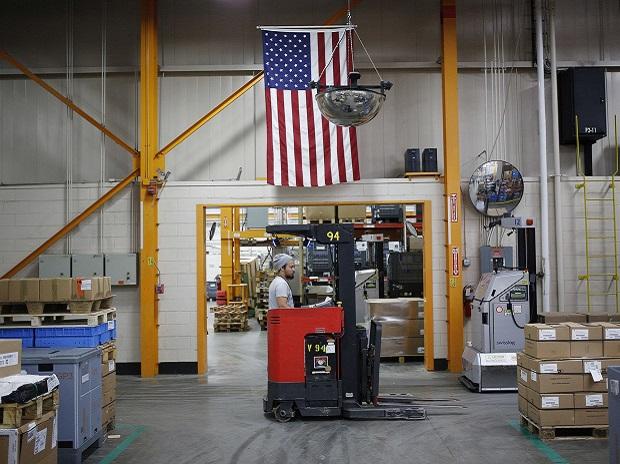[ad_1]
-The US economy grew faster than forecast into the end of 2022, but there were signs of slowing underlying demand as the steepest interest-rate hikes in decades threaten growth this year.
Gross domestic product increased at a 2.9% annualized rate in final three months of 2022 after a 3.2% gain in the third quarter, the Commerce Department’s initial estimate showed Thursday. About half of the GDP increase reflected inventory growth, while government outlays matched the biggest gain since early 2021.
Personal consumption, the biggest part of the economy, climbed at a below-forecast 2.1% pace.
The mixed report suggests that the Federal Reserve still has a path to a soft landing with officials set to further downshift their rate increases next week and debate when to pause. Their preferred price gauge rose at the slowest pace in two years, while a separate report showed unemployment filings remained near historic lows.
The data showed some signs of stress for American consumers whose wages have failed to keep up with inflation and continued to encourage them to draw down savings accumulated from government pandemic-relief programs. The burden of elevated prices and higher borrowing costs is mounting, pointing to a tenuous outlook for the economy.
“When we look at what’s happening with the consumer, which is the backbone of the US economy, we are seeing a clear loss of momentum,” Lindsey Piegza, chief economist at Stifel Nicolaus & Co., said on Bloomberg Television.
“Without the consumer happy and healthy out in the marketplace, we simply cannot expect to maintain positive growth, let alone more robust growth similar” to the end of last year, she said.
A key gauge of underlying demand that strips out the trade and inventories components — inflation-adjusted final sales to domestic purchasers — rose an annualized 0.8% in the fourth quarter after a 1.5% gain. Final sales to private domestic purchasers climbed just 0.2%, the weakest since the second quarter of 2020.
What Bloomberg Economics Says…
“Consumer spending on services drove the economy to solid growth in the fourth quarter, but the good news ends there. Two measures of underlying activity that strip out volatile components — including trade, inventory swings, and government spending — showed considerably milder growth.”
— Eliza Winger, economist
The latest Bloomberg monthly survey shows economists see the economy shrinking in the second and third quarters, putting 65% odds on a recession in the coming year.
The S&P 500 opened higher, Treasury yields rose and the dollar was little changed after the GDP report and better-than-expected weekly jobless claims. Applications for unemployment insurance dropped to 186,000 last week, the lowest since April.
Recent data show cracks are developing more broadly. Retail and motor vehicle sales data showed households are starting to retrench, the housing market continues to weaken and some businesses are reconsidering capital spending plans.
As the Fed continues to hike interest rates to ensure inflation is extinguished, housing and manufacturing have deteriorated quickly while industries including banking and technology are carrying out mass layoffs.
The GDP report showed the personal consumption expenditures price index, a key inflation metric for the Fed, rose at an annualized 3.2% rate in the fourth quarter, the slowest since 2020 and down from a 4.3% pace in the prior three months.
The core index that excludes food and energy climbed at a 3.9% rate, the slowest since the first quarter of 2021 after 4.7% paces in the prior two quarters. Monthly data for December will be released Friday.
The moderation in price pressures is consistent with forecasts that the Fed will further scale back its tightening campaign next week, when it’s expected to raise rates by 25 basis points. Policymakers boosted the benchmark rate by 50 points in December after 75 basis-point hikes at their previous four meetings.

Last Year
The world’s largest economy expanded 2.1% last year. In 2021, when demand snapped back from pandemic-related shutdowns, the economy grew 5.9% — the best performance since 1984.
The GDP data showed services spending increased at 2.6% annualized rate in the October-December period, the slowest since last year’s first quarter. Outlays on goods rose at a 1.1% pace, the first advance since 2021.
Business investment slowed sharply after a third-quarter surge. Spending on equipment declined an annualized 3.7%, the most since the second quarter of 2020.
Another report Thursday showed bookings for nondefense capital goods excluding aircraft, a proxy for business investment, dropped 0.2% in December — the most in three months.
How Executives See It
-
“The outlook for 2023 remains uncertain. In the US, central bank rate increases of started to have an impact on inflation, but they are also lowering the growth trajectory of the economy.” — David Solomon, CEO at Goldman Sachs Group Inc., Jan. 17 earnings call
-
“The activity we’re seeing feels okay. But we are, like everybody else, a bit nervous about where things are going.” — Daniel Florness, CEO at Fastenal Co., Jan. 19 earnings call
-
“If past behavior over the last six months, nine months is any indication, I think the consumer is relatively steady in the US, which gives us great confidence.” — Andre Schulten, chief financial officer at Procter & Gamble Co, Jan. 19 earnings call
-
“This is not going to be like a normal recession, that’s why you hear us and others talking about the manageability and the mildness that’s likely if we do have one.” — Jane Fraser, chief executive officer at Citigroup Inc., Jan. 13 earnings call
Residential investment slumped at a 26.7% annual pace, marking the seventh-straight quarterly decline. Home sales fell last year by the most since 2008 as mortgage rates skyrocketed.
Inventories contributed 1.46 percentage points to GDP, while trade added 0.56 percentage point. Separate data on Thursday showed the merchandise-trade gap widened last month to the largest on record due to the biggest-ever increase in imports. The figures aren’t adjusted for inflation.
[ad_2]
Source link



